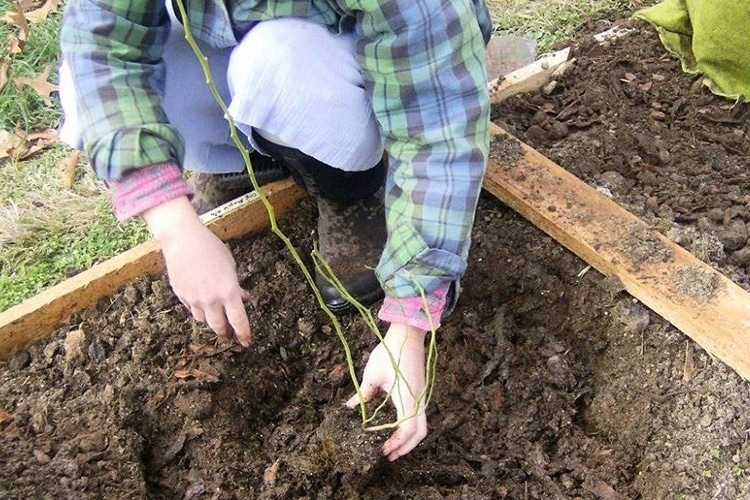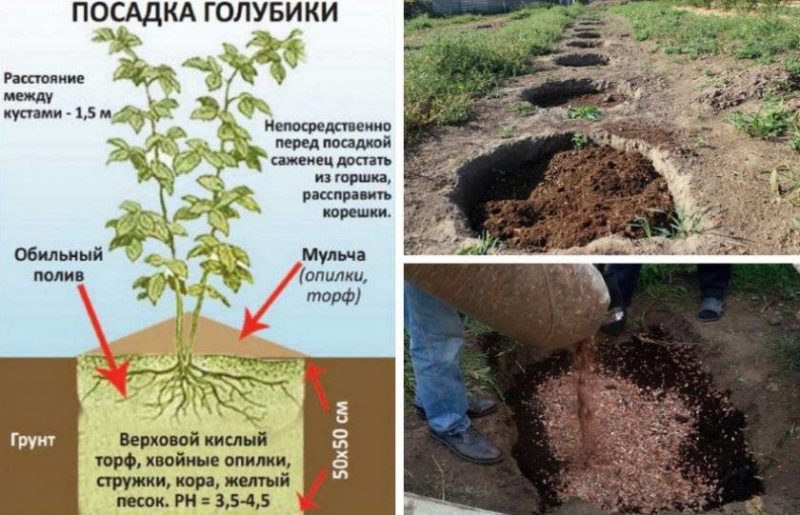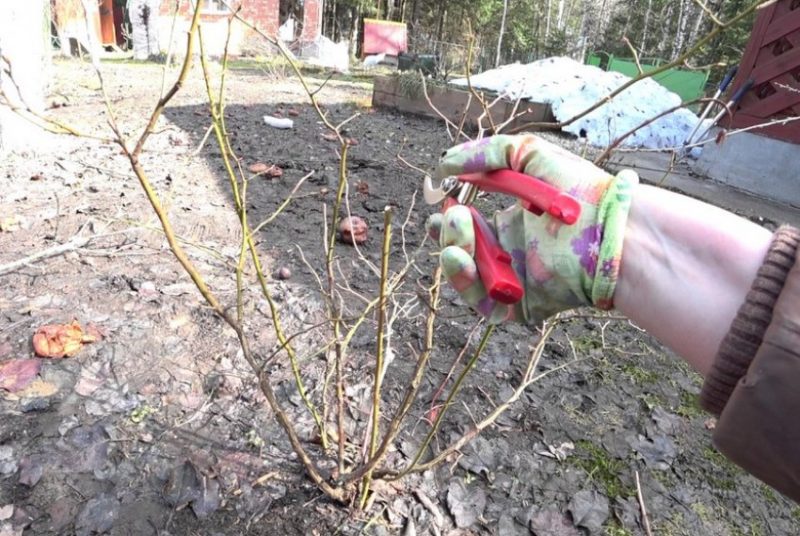A Step-by-Step Guide to Planting Blueberries in the Fall
Blueberries are a northern crop, the berries of which contain a lot of vitamins and have an excellent refreshing taste. Growing this shrub has its own nuances. In this article we will talk about planting blueberries in the fall and reveal the principles of caring for and wintering the plant.
Is it possible to plant blueberries in the fall?
Gardeners practice both spring, and autumn planting of blueberries. The difficulty of the work lies in the fact that the root system of the plant looks like a sponge and has no hairs. This makes it difficult for nutrients to come from the soil and slows down the process of formation of the above-ground part of the plant. The timing of planting blueberries is not of fundamental importance; The main thing is that the crop takes root on the site.
In practice, many gardeners prefer autumn planting, explaining their choice by the fact that the seedlings have time to take root and adapt to new conditions before they begin to actively grow in the spring. Autumn planting eliminates the need to do it in the summer and spring, when the bushes suffer from insect attacks. There are no disadvantages to planting blueberries in autumn.

Optimal timing
Blueberries with an open root system are planted immediately after harvesting the berries. The timing is selected taking into account the growing region. The main condition is the soil temperature not higher than +5°C. Taking this feature into account, in the middle zone seedlings are planted in mid-October, in the south - in early November, in the north - in mid-September.
Planting material with a closed root system can be planted at any time due to the fact that the roots are resistant to drought and frost.
Selecting a location
Blueberries prefer light, open areas. In the shade, the crop grows poorly, the berries become smaller and become sour. It is not recommended to plant bushes in lowlands where rain and melt water accumulates. This increases the risk of developing root rot.
Advice. If your site is located in a lowland, create an artificial mound 4-5 months before planting blueberries.
Soil preparation
The optimal soil acidity for planting blueberries is 3–4 pH.. In acidic soil, crop yield increases significantly. The absence of hairs on the roots allows the plant to develop in close connection with ericoid mycorrhiza, a fungus that lives only in acidic soil and promotes the absorption of beneficial components from the lower layers of the soil.
Black soil or sandy soil is ideal for blueberries. You can prepare the soil yourself: mix turf with peat and sandstone in proportions 1:3:2. Heavy clay soil is lightened with sandstone 1:3. Also for planting you will need a deep hole that can accommodate a large volume of drainage.
Planting material
The optimal age of blueberry seedlings is 2–3 years. Each of them should have annual growth and strong branches. Before purchasing, planting material is inspected for signs of disease and mechanical damage. The roots of a seedling with a closed root system should look out of the drainage. Their absence indicates infection with root rot.
Planting pit
The optimal depth and width of the planting hole is 50–65 cm. Some gardeners prefer to dig holes measuring 80x90 cm, since the roots of the shrub are constantly increasing in size.Sides are built around the planting hole to prevent garden turf from getting into the tree trunk. To do this, use plastic, brick or wood. Geological textiles are placed at the bottom to prevent the soil acidity level from decreasing.
Sawdust is poured onto the textiles in a layer of 20–30 cm. It is not recommended to use chalk or other types of crushed stone, as they reduce the acidity of the soil.
A week before planting seedlings in the hole, add:
- peat (50%),
- rotted pine needles (30%),
- sand (20%).
You can also buy a ready-made substrate made from organic substances - “Aeration mixture for blueberries” (manufacturer “Bona Forte”).
How to plant blueberries in the fall
The best neighbors of blueberries are considered to be crops that do not require organic feeding: raspberries, red currants, gooseberries, cranberries and lingonberries.
Step-by-step planting instructions
To plant blueberries you will need:
- bayonet-shovel for digging a hole,
- rake for removing plant residues and leveling the soil in the tree trunk circle,
- 10 liter bucket for watering seedlings,
- mulch.
Landing algorithm:
- Dig a planting hole and pour a nutrient mixture prepared in advance onto the bottom. The height of the embankment is 20-30 cm.
- Place the seedling vertically in the center of the hole and straighten the roots.
- Sprinkle the bush with fertile soil taken from the top layer and compact it a little in the root area.
- Water the seedling with water at a temperature of +24…+30°C. Wait for the soil to settle a little and then fill the hole to the brim.
- Lay out a layer of mulch made of peat, pine needles, river sand and bark 5–10 cm high.
Mistakes to Avoid
When growing blueberries on sandy soil, hay must be mixed into the mulch.. On clay and loamy soils, plant components are not used, since they lead to rotting of the roots and also block the access of air and moisture.
Compost and humus should not be used to feed blueberries, as they increase the alkaline balance of the soil.

Features of planting depending on the blueberry variety and region
Wild blueberry varieties prefer marshy areas. Their neighbors are often wild rosemary and blueberries. The soil in such an area is always wet, and in summer it is heated by the sun. In Russia, blueberries grow in Siberia, the Far East, the Urals, Altai, and the Caucasus.
Blueberries are very popular on the market, so gardeners are trying to grow the crop in their garden plots. Moreover, not every variety can be grown without problems in a particular region.
In the Moscow region, the most successful varieties are considered to be early and mid-season:
- Erliblue;
- Patriot;
- Blue Ray;
- Duke;
- Thoreau;
- Bluecrop.
In addition to the ripening time, garden blueberries differ in the height of the bushes: low-growing, medium-growing and tall. In the north of the country it is recommended to grow tall bushes. Due to long branches, plants receive normal sunlight.
The most popular varieties:
- Herbert - 1.8–2.3 m;
- Elizabeth - 1.7–1.9 m;
- Jersey - 1.6–2.1 m;
- Bluecrop - 1.6–2 m.
Medium-sized varieties - Weymouth, Northblue, Northland, Blyuetta - can be planted in different climatic zones. They are distinguished by high adaptive abilities, have immunity to viral and bacterial diseases, and insect pests.
In regions characterized by temperature fluctuations and little snowy winters, it is better to grow varieties with a height of 0.6-1.2 m. The bushes will not die even at a temperature of –34°C.
Further care
When caring for blueberries, the gardener must maintain an optimal level of humidity and water after a certain period of time. The bushes need to be fed with mineral supplements to accelerate development, and also monitor their health.
Watering
Watering after planting is carried out frequently - every 5-7 days. Water consumption per bush is 20 liters. Add 20 ml of table vinegar 9% per 10 liters to the water. After watering, the soil is loosened to a depth of 8 cm and weeds are removed. In hot weather, the plant is watered by sprinkling.
Top dressing
To begin with, we will talk about the general rules for fertilizing blueberries in spring and summer, then we will move on to the issue of applying fertilizers in the fall.
A hole 10–20 cm deep is dug around the bush, liquid fertilizer is poured into it or granular substances are poured into it. The procedure is performed 2-3 days after watering so that the fertilizers penetrate deeper into the soil and are absorbed into the root system.
The first portion of fertilizer is applied 7 days before the expected cold snap. 60 g of superphosphate is placed under the bush, which reliably protects the roots from frost.
The second portion is added during the period of kidney swelling. This time, nitrogen fertilizing is used, which increases the plant’s resistance to frost and promotes active development. Ammonium sulfate (50 g/10 l) is best suited. The prepared solution is poured under 1 bush. Nitrogen is also often used for this purpose. 20 g of the substance is added to the root.
The third feeding is carried out after flowering - during the formation of the ovaries. It is recommended to use potassium and magnesium (100 g/10 l). Consumption per bush - 20 l. This fertilizing increases the sugar content of the berries.
Reference. If there is a deficiency of minerals in the autumn, blueberries are fed with potassium nitrate and potassium sulfate. The granules are poured into the soil for digging.In the fall, it is better to refrain from nitrogen-containing fertilizers.
Trimming

Young bushes are trimmed every year: dry and diseased branches are removed. If cracks and spots appear on the blueberries after wintering, it means they have suffered from frost. Frozen parts are removed to the very base to reduce the risk of disease development.
Adult bushes over the age of 10 years are rejuvenated: adult shoots are shortened so that their height does not exceed 15 cm.
Wintering
Preparations for wintering begin in the fall and are carried out in several stages:
- To begin with, moisture-recharging irrigation is carried out to create the required volume of moisture that will nourish the plant.
- Next, mulch is added to the soil to retain heat and moisture at the roots.
- The soil is acidified using 9% table vinegar (20 ml per 10 l).
- Young bushes are covered with dense, breathable fabric. Agrofibre or burlap is suitable for this purpose. To fix the material, nylon threads are used and the cover is secured with additional oppression.
- Adult bushes are bent to the ground in advance so as not to break them when tying. If the branches themselves lie on the ground, they are covered, tied and placed on top of boards to securely fix the material.
- After snow falls, snow sheets are thrown over the shelter.
In spring, the shelter is removed after a stable temperature above 0°C has established.
Reproduction

It is recommended to buy blueberry seedlings in specialized nurseries, but the crop can also be propagated by layering and partial bushes.
Reproduction by layering is performed in early spring. Young flexible shoots are laid on the ground and sprinkled with sawdust. After roots appear on them (after 1.5-2 years), they are separated from the bush and transplanted to a new place.
Propagation by partial bushes is carried out using young plants that are formed from the buds of underground rhizome shoots. The gardener carefully examines the bush and determines where to separate the young plant. It can be identified by the presence of its own root system. The partial bush is dug up, separated from the mother bush and transplanted to a permanent place.
Diseases and pests
Blueberries are often affected by anthracnose, blossom rot, phomopsis, moniliosis and red spot. Infection occurs as a result of poor quality care.
- Flower rot determined by dry shoots and yellow leaves. Ulcerations appear on the branches, which lead to the death of the bush. To combat, use “Euparen” (100 g/5 l of water).
- Symptoms Phomopsis are as follows: brown spots on leaves with a diameter of 1 cm, dry shoots. For treatment, use “Fundazol” (50 g/5 l) or “Toxin” (50 g/3 l).
- Moniliosis leads to the appearance of yellow and brown spots on leaves and berries. Treatment is carried out using Karbofos (100 g/5 l).
- Anthracnose appears as orange dots on the berries. To combat it, use “Fufanon” (20 g/5 l).
- Red spot recognized by crimson and light brown spots on the leaves. Treatment is performed with Bordeaux mixture (30 g/5 l). The bushes are treated once a month until the symptoms disappear completely.
Blueberries are often attacked by aphids, chafers, leaf rollers and flower beetles. The main rule for preventing the spread of insects is removing weeds. “Oxychom” (30 g/3 l) is used against aphids, “Terpel” (2 ampoules/5 l) against cockchafers, “Skor” (40 g/5 l) against leaf rollers, and “Tridex” against the flower beetle ( 100 g/5 l).
Viral and bacterial diseases are easier to prevent using agrotechnical procedures:
- The bushes must be regularly watered, weeded, and weeds removed.
- In spring, plants are watered with boiling water (+80…+90°C).
- At the end of March, the bushes are sprayed with a solution of copper sulfate (10 g/20 l).
Advice from experienced gardeners

We have prepared some tips from experienced gardeners that will help you avoid mistakes when growing blueberries:
- Avoid overwatering the bushes, especially before wintering. Water that is not absorbed into the soil will freeze and the plant will die.
- Don't overdo it with vinegar when acidifying the soil. Too acidic soil is detrimental to the crop and negatively affects the growth and development of the plant.
- Loosen the soil within 3 cm so as not to affect the root system.
- Use nitrogen fertilizers in the spring solely to help the plant gain green mass. Use mineral supplements in summer and fall.
Conclusion
Caring for blueberries is simple, but labor-intensive. The gardener must adhere to a whole system of agrotechnical practices. The autumn planting method eliminates the need to care for young bushes in the spring and summer and ensures excellent plant survival. At the same time, it is important to properly prepare for wintering: conduct moisture-recharging irrigation, feed the bushes with mineral supplements, trim old branches.